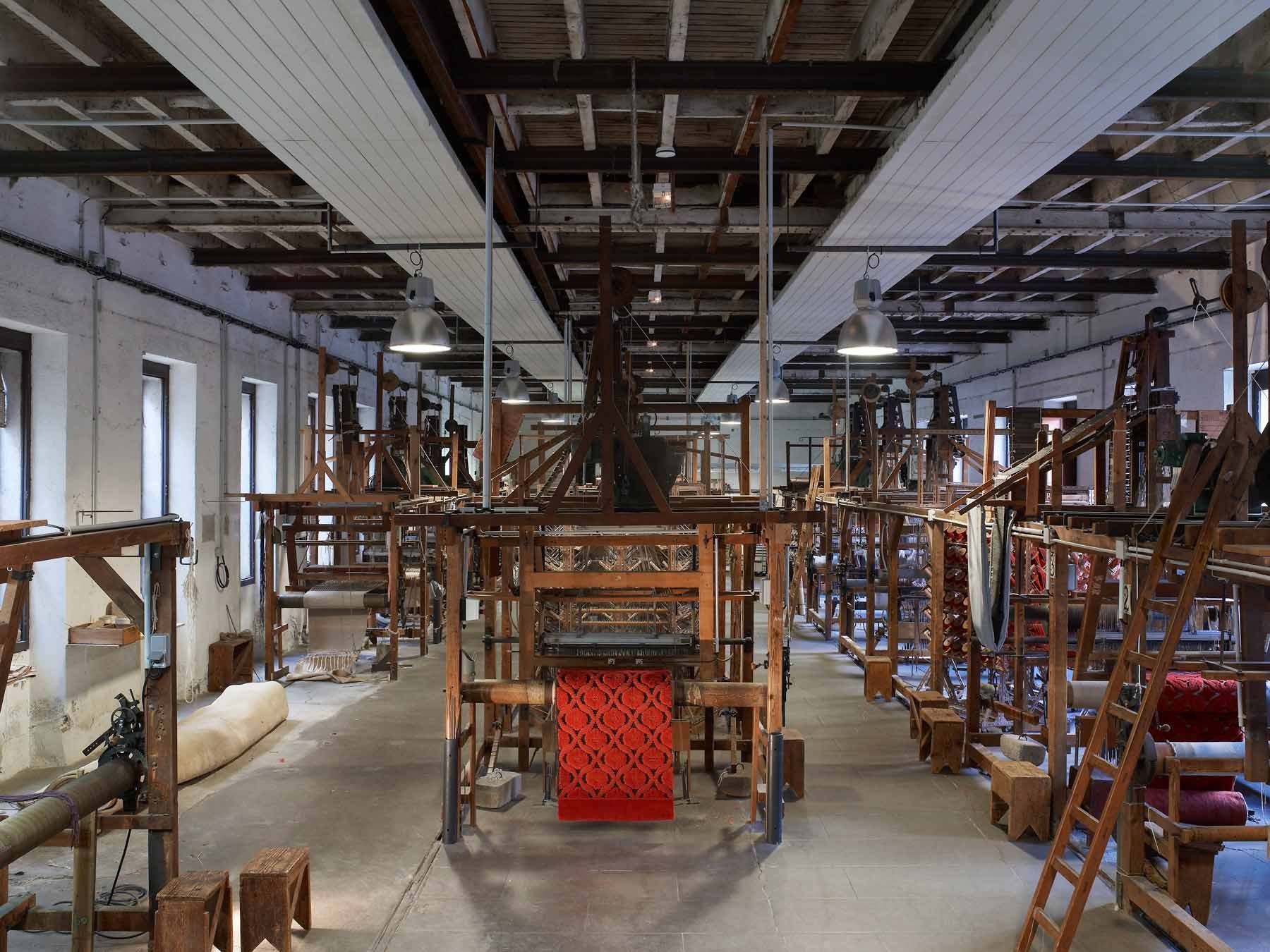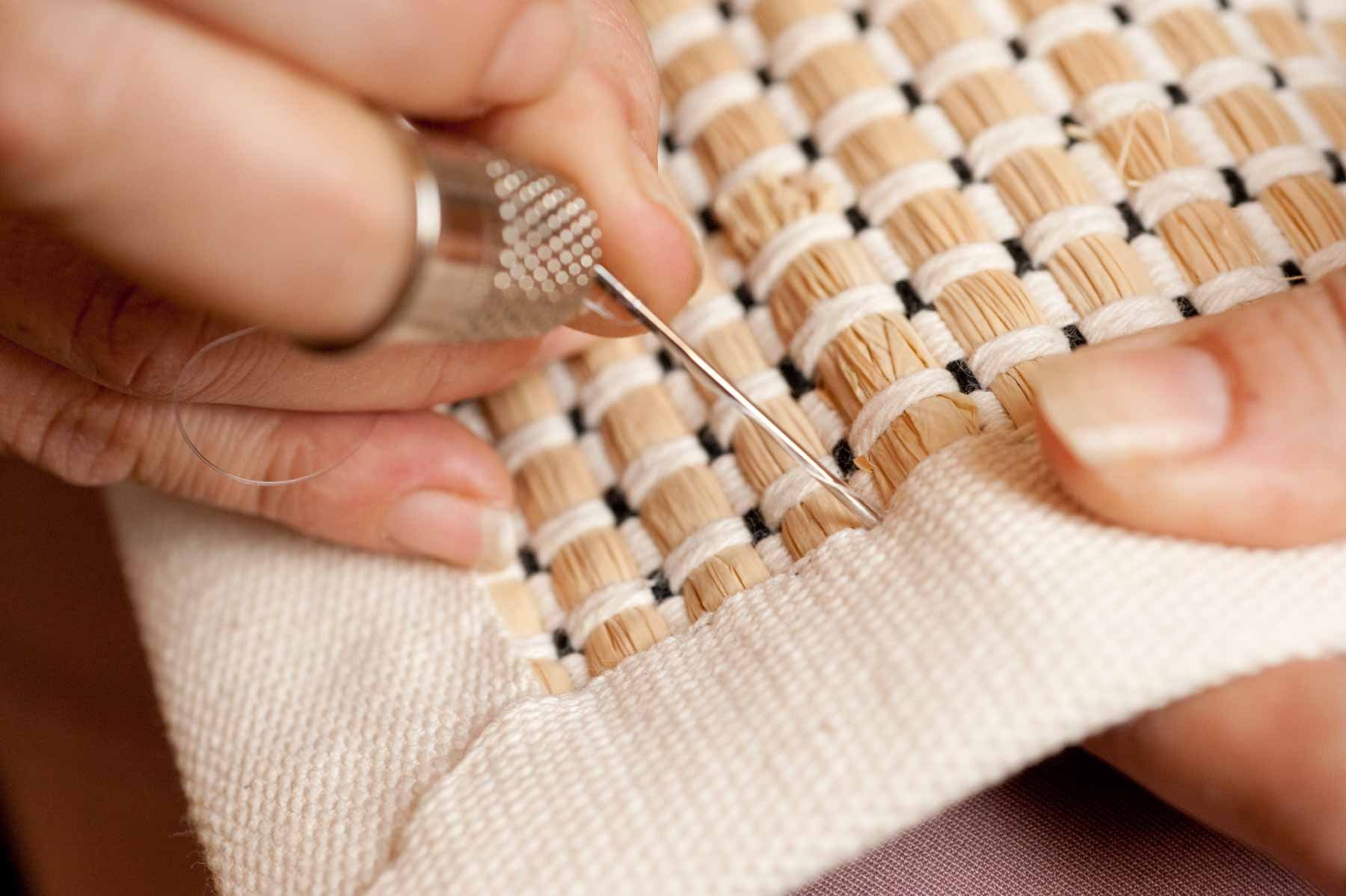Preserving a slow art form
All photos courtesy of La Manufacture Cogolin
by Emily Cathcart
In a small village near Saint-Tropez, La Manufacture Cogolin has been producing rugs of unrivaled elegance since 1924, painstakingly hand-knotted or woven by local craftswomen on 19th century looms. In conversation with Managing Director Sarah Henry, ALHAUS learns how they draw on the heritage of the past and embrace the innovations of the present.
In an age of mass production and instant gratification, these handmade pieces take time and patience to create. Are La Manufacture Cogolin’s bespoke, artist-designed rugs the ultimate ‘slow’ art form? Managing Director Sarah Henry thinks so: “For sure it is a long process! We spend quite a bit of time on the design development and the transformation of a two-dimensional drawing into a textile piece. Most often we do one or two rounds of samples when developing a collection or working on a fully custom rug, so that our partner can best understand what the finished product will look like. And then, depending on the size, the production time takes about 4-6 months.”
Pieces are crafted using four traditional techniques: cantres (pattern weaves); texturés (textured weaves); tissés plats (flat weaves); and noués main (hand-knotted). The results are exquisite but also made to last—marrying practicality and style in a world where buyers are seeking art forms that will outlive passing fads. As Sarah explains, “With people becoming more aware of the problems created by fast fashion and fast design, I think that durability—both physically and in terms of design—is increasingly important to our clients. Our rugs are not ‘trendy’. They have a timeless quality that is easy to live with and doesn’t go out of style—which is good, because they are made to last for generations!”
With their rugs decorating palaces, embassies, lavish residences and yachts around the world, the hallmarks of La Manufacture Cogolin include not only exceptional craftsmanship, but collaboration with a stellar cast of designers including India Mahdavi and Stéphane Parmentier. Sarah elaborates on how they form these relationships: “When we work with designers or artists on collections, we look for collaborations with people who fit with the DNA of the brand. For a collection to work, it needs to make sense with the style of the brand, as our clients are looking for something pretty specific from us. Often collaborations grow from working with existing clients who understand our rugs and have a special connection to the brand—that makes the process easier. And sometimes a collaboration for a collection can stem from an interesting introduction, or by expanding a unique project initially realised for an exposition or event.”
To stay true to their brand DNA, storytelling—and respecting their backstory in the process—are also key considerations at La Manufacture Cogolin. “One of the first things I do when planning a new collection is to evaluate what seems to be missing in our existing product offer, in order to better round out what we can propose to our clients. We are not a huge company with unlimited resources, so there has to be a good reason for everything that we do—new products need to make sense with our history, designer collaborations have to fit with the image of our brand, etc.
“When we talk about our collections, storytelling is an important element that enhances the value of the physical goods and helps our clients connect to the brand. La Manufacture Cogolin is nearly 100 years old, so we have a lot of stories about where we have come from, as well as new stories that develop as we create collections with contemporary designers.”
One of these collections—Jardin intérieur by India Mahdavi—is particularly notable for its different weave heights, adding luxurious texture and movement to each piece. Sarah tells us more about this clever adaptation of classic techniques: “Three-dimensional weaving is an aspect of most of our narrow-loom rugs. It’s a style that we originally realised in the mid-20th century using a Mediterranean hand-knotting technique. We modified our 19th-century Jacquard hand looms in the 1960’s to increase the speed of weaving and ensure the future of the company—originally the looms were used for weaving fabric, then for simple textured rugs.
“Since the late 1960’s La Manufacture Cogolin has been best known for these plush and graphic rugs, as well as for our flat-woven raffia rugs. Technically our rugs are like a thick velvet fabric, with a warp and weft crossing to create the ground of the rug, and a creel of bobbins behind the loom that create the pile as the yarn is wrapped around rods of different thicknesses that produce different pile heights.
“Our rugs are woven in 70cm-wide panels that are sewn together by hand, and we can weave panels between 2-2,8m long per day, depending on the skills of the weaver.”
These weavers at their factory in the village of Cogolin are relying on 19th century French Jacquard looms. Sarah talks us through the benefits of using such traditional equipment and methods, as well as some of the challenges: “The beauty and the challenge of what we do lies with using traditional techniques. It’s a challenge, because we are constantly making minor repairs to our looms but we can’t just purchase parts—we have to have parts custom-made, and we have a full-time mechanic on staff. Even our yarns are spun bespoke to our specifications.
“The looms and Jacquard mechanisms are made from wood, so they are like musical instruments that need to be tuned according to differences in temperature and humidity. Finally, making artisanal products by hand in France is quite expensive as the labour costs are much higher than in developing countries, and the time to train new apprentices is quite long.”
But protecting this artisan culture and keeping the past alive is well worth the effort: “There is something very rewarding in preserving traditional craftsmanship. We train all of our employees in our atelier, and it is exciting to see their skills progress. Entering the workshop is like stepping back in time 150 years—it’s a magical place, and everyone on our staff is conscious of the uniqueness of what we are doing. Our rugs have a special quality that can’t be copied.”
It’s not just the finished product itself and the craft that goes into it that are unique. Sarah conveys how the development that goes into fostering their staff’s skills is an uncommon labour of love: “We are part of a larger group, but La Manufacture Cogolin is run like a family business. Our team is 90% women, so it’s quite a different environment from most companies. The weaving and sewing of our rugs is a slow process that takes a lot of precision and patience. It takes years for our artisans to develop their skills, so we do everything we can to make sure that they—and the rest of our employees—feel valued and involved in the company. Communication is really important, and a simple ‘thank you’ goes a long way.
“We provide opportunities for advancement; flexibility in working hours to allow employees who have needed to take time off here and there for personal reasons to be able to make up the hours; and we issue bonuses based on individual and collective results. We take time out to celebrate our successes as a team.
“As the managing director, I spend about a week each month at the workshop. When I am there I always walk through the ateliers and talk with the team about where the rugs will be shipping, who they are for, and I work together with the team to trouble-shoot technical issues and improve techniques. About once a quarter we have a formal meeting to inform the team about how we are doing and where the company is going.
“As there is a lot of communication with our clients in order to develop our bespoke rugs, they feel quite involved in the process and are invested in the final result. We often send photos of rugs while they are on the loom, and some of our clients even come to visit their rugs while they are in production.”
So what's next for La Manufacture Cogolin? Are there new collaborations or design techniques in the pipeline? “We have a lot in development! In January we are launching a capsule collection of vintage Mediterranean rugs from our archives, and we have another rug collection in development with an outside designer for late 2023 or early 2024. Stay tuned!”






